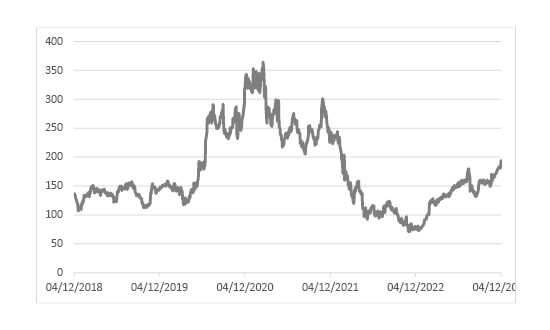


When music streaming platform Spotify’s announcement of a return to profitability was immediately followed by plans for further job cuts , its share price jumped more than seven percent.
There’s nothing investors like more than hearing an executive team has their fingers wrapped tightly around a company’s’ purse strings.
Costs have become a major issue over the past year, and even as inflation cools businesses are having to get used to the new economic landscape where money is expensive and labour a significantly increasing expenditure.
But 17% is a significant chunk of Spotify’s workforce and comes off the back of two separate culls earlier in the year, which must prompt questions about whether the company can maintain performance with such a reduction in headcount.
Spotify share price performance

Source: Refinitiv
Year to date Spotify’s share price is up almost 150% as the company reined in spend on controversial podcast creators like Prince Harry and his wife Megan, bumped up prices and still managed a significant growth in subscriber numbers.
In a letter to employees, Spotify’s chief executive, Daniel Ek said that “substantial action to right-size our costs was the best option to accomplish our objectives,” which include ultimately reaching a billion users by 2030.
But 17% is a significant chunk of Spotify’s workforce and comes off the back of two separate culls earlier in the year, which must prompt questions about whether the company can maintain performance with such a reduction in headcount.
Attracting users to the service requires creating unmissable content and delivering a consistent user experience. Any slippage would result in audiences defecting to competitors more than happy to add to their own numbers.
Spotify is far from alone in its predicament.
Many tech companies rushed to build up their employee base during the pandemic, and are now having to reassess as the economic backdrop becomes more uncertain and growth slows significantly.
According to layoffs.fyi, the website that tracks tech job cuts, tech companies globally laid off 165,000 employees in 2022.
That number has jumped to over 255,000 tech workers being let go in 2023 to date, once you factor in the latest Spotify cuts.
British Telecom announced in May it was turning to AI to replace some of the 55,000 workers it plans to axe by the end of the decade, others like Meta told investors they’d simply got the sums wrong and had hired too many people too quickly without a clear business need.
Always controversial, X (Twitter) boss Elon Musk said during an interview at the Wall Street Journal’s CEO Council in May that he felt many companies could and should go much further, seeing “potential for significant cuts at other companies without affecting their productivity, in fact increasing their productivity.”
Many analysts have delivered similar commentary on the changing jobs picture but considering the current trajectory for Mr Musk’s social media platform following a massive reduction in headcount there will likely be many taking what he has to say with a liberal pinch of salt.
Investors aren’t wrong to want profitability, they aren’t wrong to be worried about costs, but they should also concentrate on outlook and ambition
The efficacy of that stance is questioned in JP Guthrie’s paper entitled ‘Dumb and Dumber: The impact of downsizing on firm performance as moderated by industry conditions’.
It raises questions about the impact of cuts on the productivity of those left behind and finds there can be subsequent decreases in profitability following down-sizing.
Morale is crucial, especially for companies like Spotify with an eye on continued growth.
Then there’s the conundrum that if the company does achieve that growth, if it then needs to add to its headcount, it must find employees with the same skillset to replace those it let go.
Training and skills are often quoted as two of the things needed for an economy to grow, and training can take time and money if it’s done correctly.
Investors aren’t wrong to want profitability, they aren’t wrong to be worried about costs, but they should also concentrate on outlook and ambition, and CEOs need to consider the value of staff beyond that of costs that need to be minimised, in order to deliver an upbeat message on an earnings call.
Just because the economy seems to be downshifting doesn’t mean it won’t need to accelerate in order to turn the corner.
And of course, there’s also the question about where those skilled workers might end up, because if it’s in the employ of a competitor the repercussions could be felt for years.
Past performance is not a guide to future performance and some investments need to be held for the long term.
This area of the website is intended for financial advisers and other financial professionals only. If you are a customer of AJ Bell Investcentre, please click ‘Go to the customer area’ below.
We will remember your preference, so you should only be asked to select the appropriate website once per device.